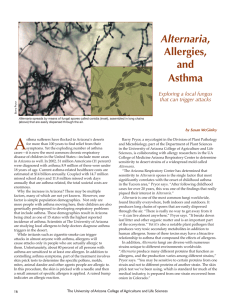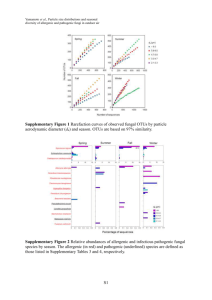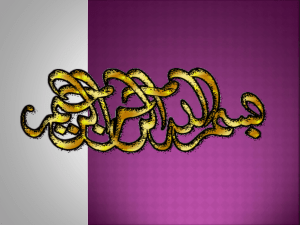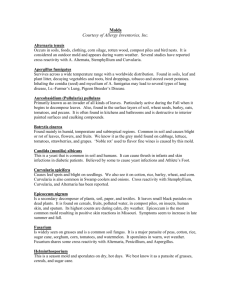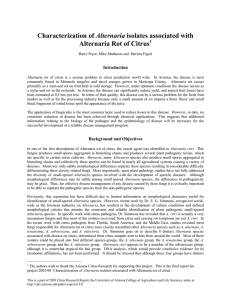Ulocladium systematics revisited: phylogeny and taxonomic status ORIGINAL ARTICLE Farhana Runa
advertisement
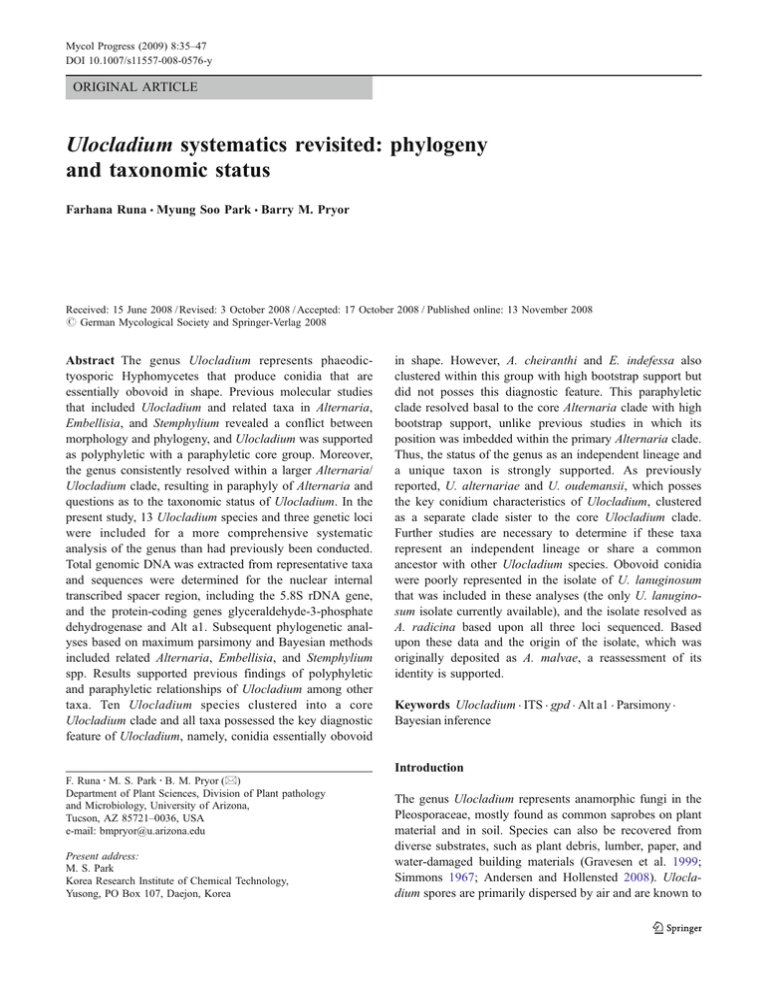
Mycol Progress (2009) 8:35–47 DOI 10.1007/s11557-008-0576-y ORIGINAL ARTICLE Ulocladium systematics revisited: phylogeny and taxonomic status Farhana Runa & Myung Soo Park & Barry M. Pryor Received: 15 June 2008 / Revised: 3 October 2008 / Accepted: 17 October 2008 / Published online: 13 November 2008 # German Mycological Society and Springer-Verlag 2008 Abstract The genus Ulocladium represents phaeodictyosporic Hyphomycetes that produce conidia that are essentially obovoid in shape. Previous molecular studies that included Ulocladium and related taxa in Alternaria, Embellisia, and Stemphylium revealed a conflict between morphology and phylogeny, and Ulocladium was supported as polyphyletic with a paraphyletic core group. Moreover, the genus consistently resolved within a larger Alternaria/ Ulocladium clade, resulting in paraphyly of Alternaria and questions as to the taxonomic status of Ulocladium. In the present study, 13 Ulocladium species and three genetic loci were included for a more comprehensive systematic analysis of the genus than had previously been conducted. Total genomic DNA was extracted from representative taxa and sequences were determined for the nuclear internal transcribed spacer region, including the 5.8S rDNA gene, and the protein-coding genes glyceraldehyde-3-phosphate dehydrogenase and Alt a1. Subsequent phylogenetic analyses based on maximum parsimony and Bayesian methods included related Alternaria, Embellisia, and Stemphylium spp. Results supported previous findings of polyphyletic and paraphyletic relationships of Ulocladium among other taxa. Ten Ulocladium species clustered into a core Ulocladium clade and all taxa possessed the key diagnostic feature of Ulocladium, namely, conidia essentially obovoid in shape. However, A. cheiranthi and E. indefessa also clustered within this group with high bootstrap support but did not posses this diagnostic feature. This paraphyletic clade resolved basal to the core Alternaria clade with high bootstrap support, unlike previous studies in which its position was imbedded within the primary Alternaria clade. Thus, the status of the genus as an independent lineage and a unique taxon is strongly supported. As previously reported, U. alternariae and U. oudemansii, which posses the key conidium characteristics of Ulocladium, clustered as a separate clade sister to the core Ulocladium clade. Further studies are necessary to determine if these taxa represent an independent lineage or share a common ancestor with other Ulocladium species. Obovoid conidia were poorly represented in the isolate of U. lanuginosum that was included in these analyses (the only U. lanuginosum isolate currently available), and the isolate resolved as A. radicina based upon all three loci sequenced. Based upon these data and the origin of the isolate, which was originally deposited as A. malvae, a reassessment of its identity is supported. F. Runa : M. S. Park : B. M. Pryor (*) Department of Plant Sciences, Division of Plant pathology and Microbiology, University of Arizona, Tucson, AZ 85721–0036, USA e-mail: bmpryor@u.arizona.edu Introduction Present address: M. S. Park Korea Research Institute of Chemical Technology, Yusong, PO Box 107, Daejon, Korea Keywords Ulocladium . ITS . gpd . Alt a1 . Parsimony . Bayesian inference The genus Ulocladium represents anamorphic fungi in the Pleosporaceae, mostly found as common saprobes on plant material and in soil. Species can also be recovered from diverse substrates, such as plant debris, lumber, paper, and water-damaged building materials (Gravesen et al. 1999; Simmons 1967; Andersen and Hollensted 2008). Ulocladium spores are primarily dispersed by air and are known to 36 be common airway allergens (Al-Suwaine et al. 1999). In addition, some species have been reported as opportunistic human pathogens (de Hoog and Horre 2002). The genus Ulocladium was first established by Preuss (1851) with U. botrytis as the type. Species are represented by dematiaceous phaedictyosporic Hyphomycetes with conidia essentially obovoid in shape. Related genera such as Alternaria and Stemphylium are also been characterized by the production of dematiaceous phaedictyospores (Nees 1816; Elliot 1917; Joly 1964; Neegard 1945; Simmons 1967; and Wiltshire 1933) and early taxonomy for this group of fungi was complicated because of gross similarities in conidium morphology among genera. As a consequence, many species have been placed into more than one of these genera since their initial description and the taxonomy of these fungi, especially Ulocladium, evolved with considerable historical controversy. For example, before a formal description of the genus Ulocladium, the type, Ulocladium botrytis, had been known by the synonyms Stemphylium botryosum Wallr. var. Ulocladium Sacc., v.s. and Stemphylium botryosum Wallr. var. botrytis (Pr.) Lindau, v.s. Following circumscription of the genus by Preuss with two described species, few additional taxa were added in the years following and the genus was infrequently mentioned. In 1967, the genus Ulocladium was reviewed by Simmons in his seminal paper “Typification of Alternaria, Stemphylium and Ulocladium” (Simmons 1967). Species of these three genera were reviewed based upon morphological characteristics and compared with the type for each genus. It was concluded that several atypical Alternaria and Stemphylium species should actually be classified as Ulocladium and seven additional species were included in the genus, the first additions in over 100 years. Simmons highlighted that the fundamentally obovoid and nonbeaked conidia (i.e., do not taper distally) are the principal morphological characteristics that distinguishes Ulocladium from Alternaria and other related genera (Simmons 1967). However, this distinguishing character is often best viewed only in immature conidia and may subsequently be lost as the conidia mature. Moreover, ellipsoidal and spherical forms may also be common in some species, particularly among mature conidia. In regard to Stemphylium, species could be readily differentiated from Ulocladium on the basis of the conidiophores apex and the percurrently proliferating conidiophore, which are the major morphological characteristic that distinguishes Stemphylium from other phaedictyosporic Hyphomycetes (Simmons 1969). Another genus with ties to Ulocladium, Alternaria and Stemphylium is Embellisia Simmons. These phaeosporic Hyphomycetes have conidia that are morphologically reminiscent of both phragmosporic Helminthosporium species and dictyosporic Alternaria species (Simmons 1971). Description of the diagnostic characteristics of Mycol Progress (2009) 8:35–47 Embellisia revealed by Simmons (1992) proposed a close relationship to Alternaria and other allied genera in the Pleosporaceae. However, the synonomies required during the erection of Embellisia suggested taxonomic placement may not be without some taxonomic uncertainty. In most previous studies involving Ulocladium, the phylogenetic status of the genus has only peripherally been discussed as such studies were focused primarily on allied taxa of Alternaria, Embellisia, or Stemphylium. Based on the analysis of the nuclear internal-transcriber spacer (ITS), mitochondrial small subunit (mt SSU), glyceraldehydes-3phosphate dehydrogenase (gpd) sequences and the Alternaria allergen gene Alt a1 (Pryor and Gilbertson 2000; Chou and Wu 2002; de Hoog and Horre 2002; Pryor and Bigelow 2003; Hong and Pryor 2005), a large monophyletic clade comprising Alternaria, Ulocladium, and Embellisia was supported with Stemphylium as the sister taxa. Ulocladium was revealed as polyphyletic within the paraphyletic clade of Alternaria, Ulocladium, and Embellisia. A core Ulocladium clade was revealed that included four species of Ulocladium, which possess the key taxonomic character of obovoid conidia, but also two other species, Alternaria cherianthi and Embellisia indefessa, which do not possess the key taxonomic character. In addition, U. alternariae, which does possess the key taxonomic character, did not cluster within the core Ulocladium clade. Moreover, the primary Ulocladium clade appeared to be imbedded within a larger Alternaria clade resulting in paraphyly of Alternaria and uncertainty as to the phylogenetic status of a distinct Ulocladium genus. Indeed, in a recent study by Xue and Zhang (2007), which was focused primarily on Ulocladium and was perhaps the most comprehensive review of the genus to date (seven previously described species and one newly described species), molecular data based on the nuclear ITS rDNA region and the glyceraldehyde-3-phospate dehydrogenase (gpd) gene continued to support a polyphyletic and paraphyletic Ulocladium lineage which did not resolve independent from the genus Alternaria. Thus, as continued conflict was revealed between morphology and phylogeny of Ulocladium species, it became important to further examine the phylogenetic status of Ulocladium and its relationship with allied taxa and provide additional perspectives on the disposition of the genus, especially as it relates to Alternaria. The objective of the present study was to continue to explore phylogeny and the taxonomic status of Ulocladium species based on additional taxa and additional genetic loci for phylogenetic analyses. Relationships among most described Ulocladium spp. and a number of related Alternaria, Embellisia and Stemphylium spp. were examined based on sequences from nuclear rDNA internal transcriber spacer (ITS) region and two protein coding Mycol Progress (2009) 8:35–47 genes, gpd and the Alt a1 allergen gene. Morphological characteristics were re-examined for further assessment of taxonomic relationships. Materials and methods Isolates included in this study Thirteen species of Ulocladium, twenty-five species of Alternaria, five species of Embellisia, and two species of Stemphylium were included in this study. The Ulocladium species represent most of the previously described taxa (15 total species), but not the five most recently described taxa as recorded in Index Fungorum (http://www.indexfungorum. org). Alternaria species include representatives of the five most common species-groups described to date: the asexual clades of the alternata species-group, the porri species-group, the radicina species-group, and the brassicicola speciesgroup, and the sexual clade of the infectoria species-group (teleomorph = Lewia), which has been shown in previous studies to be distantly related to asexual Alternaria (Pryor and Bigelow 2003; Hong and Pryor 2005; Xue and Zhang 2007). Isolate identity and source are included in Table 1. DNA extraction, PCR amplification and sequencing For DNA extraction and purification, previously described protocols (Pryor and Gilbertson 2000) were followed. DNA was adjusted to a final concentration of 10 ng/μL for each PCR reaction. Primers ITS4 and ITS5 (White et al. 1990) were used to amplify rDNA from the ITS region (ITS1, 5.8s, ITS2). Primers gpd1 and gp2 (Berbee et al. 1999) were used to amplify DNA from the gpd locus. Primers Altfor and Alt-rev (Hong et al. 2005) were used to amplify DNA from the Alt a1 locus. PCR products were sequenced in both the forward and reverse directions for confirmation of nucleotide with FS Dye Terminator reactions (Applied Biosystems, Foster City, CA) and ABI automated DNA sequencer. The resulting nucleotide sequences were aligned by the BioEdit Program version 7 (Hall 2004). For all amplified regions, manual adjustments of sequence alignments were performed with the data editor program MacClade Phylogenetic software (version 4.0, Sinauer Associates Inc., Sunderland, Massachusetts). For some species ITS, gpd, and Alt a1 sequences included in the alignments were determined in previous studies. (Table 1). Phylogenetic analysis of nucleotide sequences Phylogenetic analyses were performed using methods of maximum parsimony and Bayesian inference. Maximum parsimony (MP) was performed using heuristic searches 37 with random stepwise addition sequences of 1,000 replicates and branch swapping by tree-bisection-reconnection (TBR) with the “MulTree” option in effect and Max Tree was set to 1000 [PAUP 4.0 10b (Swofford 2002)]. Gaps were treated as missing. For statistical analyses of resolved trees, 1000 non-parametric bootstrap replicates were performed under the MP criteria. MrBayes 3.0b4 Software (Huelsenbeck and Ronquist 2001) was used for Bayesian analyses with four Markov chains, 2,000,000 numbers of generations, 1000 sample frequency, and 10,000 burn-in value. The model GTR+I+G obtained from Modeltest version 3.7 was used to construct Bayesian trees. PAUP 4.0b10 was used to reconstruct consensus tree with maximum posterior probability among 2000 sampled trees. Concordance between datasets was evaluated with the partition–homogeneity test (PHT). For concordant data, data sets were combined and maximum parsimony and Bayesian analyses were run as previously described. Morphological characterization of Ulocladium spp For examination of morphological characters, conidial suspensions were prepared from 7-day-old cultures on PCA and all suspensions were adjusted to an equal concentration (2.5× 106 spores/ml). Slides were prepared from spore suspensions and images acquired at 100× using a Fuji S2 digital camera (FujiFilm USA, Inc., Edison, NJ) attached to an Olympus BX51 compound microscope (Olympus America, Inc., Center Valley, PA). Five pictures of relatively full fields of view (100×) were taken and conidia (30–50) with different septa numbers (1, 2, 3 and 4) were selected and length and width were measured using Olympus Microsuite software. In addition, 50 conidia were randomly selected and transepta number determined to calculate the average transepta number per species. One way ANOVA (Sigmastat software package; Systat Software Inc., San Jose, CA) was used to determine significant differences (≤0.05) in conidium length, width, and l/w ratio for each conidium category and in average transepta/conidium, and means separation was performed using Tukey’s test. Results PCR amplification, sequencing and alignment PCR resulted in the amplification of 555–610 bp fragments using primers ITS4 and ITS5, 585–600 bp fragments using primers gpd1 and gpd2, and 416–486 bp fragments using primers Alt-for and Alt-rev, from all Ulocladium species. The sequences determined in this study have been submitted to GenBank, and these and other sequences used in this study are listed in Table 1. 38 Mycol Progress (2009) 8:35–47 Table 1 Isolates used in this study, their source, and GenBank accession numbers for sequences used in phylogenetic analyses Species Alternaria alternata A. arborescens A. brassicicola A. carotiincultae A. cheiranthi A. conjuncta A. dauci A. ethzedia A. infectoria A. limoniasperae A. longipes A. macrospora A. mimicula A. petroselini A. porri A. oregonensis A. radicina A. selini A. smyrnii A. solani A. targetica A. tenuissima Embellisia conoidea E. indefessa E. novae-zelandiae E. proteae E. hyacinthi E. planifunda E. tumida Stemphylium botryosum S. vesicarium Ulocladium alternariae U. atrum U. botrytis U. chartarum U. consortiale U. cucurbitae U. dauci U. lanuginosumb U. multiforme U. obovoideum U. oudemansii U. septosporum U. tuberculatum Sourcea EGS 34–016 EGS 39–128 EEB 2232 EGS 26–010 EGS 41–188 EGS 37–139 ATTCC 36613 EGS 37–143 EGS 27–193 EGS 45–100 EGS 30–033 DGG Ams1 EGS 01–056 EGS 09–159 ATCC 58175 EGS 29–194 ATCC 96831 EGS 25–198 EGS 37–093 ATCC 58177 EGS 44–044 EGS 34–015 CBS 132.89 EGS 30–195 EGS 39–099 EGS 39–031 EGS 49–062 CBS 537.83 CBS 589.83 ATCC 42170 ATCC 18521 BMP 0352 ATCC 18040 ATCC 18043 ATCC 18044 CBS 201–67 EGS 31–021 CBS 102062 CBS 102.26 CBS 102060 CBS 101229 CBS 114.07 CBS 109.38 CBS 202.67 GenBank accession ITS gpd Alt a1 AF347031 AF347033 AF229462 AF229465 AF229457 FJ266475 AF229466 AY278833 AY347034 FJ266476 AY278835 AF229469 FJ266477 AF229454 AF229470 FJ266478 AF229472 AF229455 AF229456 AF229475 FJ266479 AF347032 FJ348226 AY278841 AY278844 AY278842 AY278843 FJ266480 FJ266481 AF229481 AF229484 AF229485 AF229486 AF229487 AF229488 FJ266482 FJ266483 FJ266484 FJ266485 FJ266486 FJ266487 FJ266488 FJ266489 FJ266490 AY278808 AY278810 AY278813 AY278798 AY278802 AY562401 AY278803 AY278795 AY278793 AY562411 AY278811 AY278805 AY562415 AY278799 AY278806 FJ266491 AY278797 AY278800 AY278801 AY278807 AY562407 AY278809 FJ348227 AY278828 AY278831 AY278829 AY278830 FJ266492 FJ266493 AY278820 AY278821 AY278815 AY278818 AY278817 AY278819 FJ266494 AY562418 FJ266495 FJ266496 FJ266497 FJ266498 FJ266499 FJ266500 FJ266501 AY563301 AY563303 AY563311 AY563287 AY563290 AY563281 AY563292 AY563284 FJ266502 AY563306 AY563304 AY563294 AY563310 AY563288 AY563296 FJ266503 AY563286 FJ266504 AY563289 AY563299 AY563297 AY563202 FJ348228 AY563323 AY563324 FJ266505 FJ266506 FJ266507 FJ266508 AY563274 AY563275 AY563316 AY563318 AY563317 AY563319 FJ266509 AY563315 FJ266510 FJ266511 FJ266512 FJ266513 FJ266514 FJ266515 FJ266516 Sequences that were determined in the course of this study appeared in bold Abbreviations for source are as follows: ATCC, American Type culture collection, Manassas, VA 20108; BMP, B. M. Pryor, Division of Plant Pathology, Department of Plant Science, The University of Arizona, Tucson, AZ 85721;; DGG, D. G. Gilchrist, Department of Plant Pathology, University of California, Davis, CA 956161; EEB, E. E. Butler, Department of Plant Pathology, University of California, Davis, CA 95616; EGS, E. G. Simmons, Mycological Services, Crawfordsville, IN 47933; CBS, Centraalbureau voor Schimmelcultures, Royal Netherlands Academy of Arts and Sciences, Uppsalalaan 8, 3584 CT Utrecht, The Netherlands b No ex-type or representative cultures of U. lanuginosum are currently available. The isolate used in this study, CBS 102.26, is of questionable identity as revealed in this manuscript a Mycol Progress (2009) 8:35–47 Alignment of ITS sequences resulted in a 604 character dataset of which 104 characters (17.2%) were variable and 86 characters (14.2%) were parsimony informative. In the aligned data set several variable regions were apparent. A notable indel spanned characters 64–98 and was present in the sequences from U. alternariae, U. oudemansii, and the members of the infectoria and brassicicola species-groups. Alignment of the gpd sequences resulted in a 589 character dataset of which 202 (34.3%) characters were variable and 165 (28.0%) were parsimony informative. In the aligned data set two introns were present and spanned characters 23–79 and 144–267. Alignment of the Alt a1 sequence resulted in a 492 character dataset, of which 261 characters (53.0%) were variable and 219 characters (44.5%) were parsimony informative. In the aligned data set, one intron was present and spanned characters 328–404. Alignment of each data set has been submitted to Tree BASE for review (S2185). Phylogenetic analyses Maximum parsimony analysis of the ITS dataset resulted in 12 most-parsimonious trees (total length=180, CI=0.739, RI=0.915). All trees revealed Alternaria clades described in previous studies, namely the alternata species-group, the porri species-group, the radicina species-group, the brassicicola species-group, and the infectoria species-group, as well as the Ulocladium clade, the Embellisia clade, and the Stemphylium clade (Fig. 1a-k). The 12 MP trees differed only in an exchange in the position of the porri-species group and the radicina species-group, and minor changes in the relationship among members within the porri speciesgroup and the alternata species-group (Fig. 2). Among nine principle clades, four Alternaria clades (alternata speciesgroup, porri species-group, brassicicola species-group, infectoria species-group) and the Stemphylium group were strongly supported by high bootstrap values of >95%. The radicina species-group was moderately supported by a bootstrap value of 76% and the Embellisia group was weakly supported by a bootstrap value of 62%. Ten species of Ulocladium, A. cherianthi, and E. indefessa were clustered as a core Ulocladium clade, Ulocladium I, which was moderately supported by a bootstrap value of 72%. Two other Ulocladium species, U. alternariae and U. oudemansii, were clustered together in a separate clade, Ulocladium II, which was strongly supported by a bootstrap value of 99% and was immediately basal to the primary Ulocladium clade. The position of the brassicicola speciesgroup was directly basal to the two Ulocladium clades, as was the infectoria species-group. Of the deeper nodes, only the basal ones received strong bootstrap support. Interestingly, the isolate of U. lanuginosum used in this study, CBS 102.26, clustered with the radicina species-group, specifi- 39 cally with A. radicina and A. carotiincultae, and this association was strongly supported by high bootstrap value (84%). Bayesian analyses resulted in a tree with nearidentical topology as shown in Fig. 2 with minor changes in the position of radicina species-group relative to the position of porri species-group (data not shown). However support as measured by Bayesian posterior probabilities was higher and provided significant support (>95%) for most of the clades (Fig. 2). Maximum-parsimony analysis of the gpd data set yielded 16 equally (Fig. 3) most-parsimonious trees (total length=413, CI=0.663, RI=0.869), which varied only in position of the brassicicola species-group, and minor changes in the relationships among the members of the radicina species-group, the Ulocladium group and the Embellisia group (Fig. 4). The topology of the gpd trees were nearly identical to those from the ITS data set with the exception of the placement of the brassicicola speciesgroup, which was generally distal to the primary Ulocladium clade and basal to the radicina species-group. All primary clades received high bootstrap support (>95%) with the exception of the radicina species-group and the Ulocladium group, both weakly supported by a bootstrap value of 62%. As with the ITS data set, U. alternariae and U. oudemansii, clustered together in a separate clade, Ulocladium II, which was strongly supported by a bootstrap value of 99% and basal to the primary Ulocladium clade. Similarly, CBS 102.26 clustered with A. radicina with strong bootstrap support (98%). Bayesian analysis revealed a nearly identical tree as displayed in Fig. 4 with minor differences in the relationship among the members of Embellisia group. Supports measured by Bayesian posterior probabilities were higher and provided significant support for most clades (>95%) (Fig. 4). Maximum-parsimony analysis of the Alt a1 data set yielded 20 most-parsimonious trees (total length=618, CI= 0.607, RI=0.834). The trees differed only in minor changes in the relationship among members of the porri speciesgroup (Fig. 5). Topography of Alt a1 trees were nearly identical to those of the gpd trees in terms of species clusters; however, the primary Ulocladium clade was further resolved as two distinct clades, Ulocladium Ia and Ib, with the second clade composed of U. chartarum, U. septosporum, A. cheiranthi, and E. indefessa. As with the ITS and gpd data sets, U. alternariae and U. oudemansii, clustered together in a separate clade, Ulocladium II, which was strongly supported by a bootstrap value of 99% and immediately basal to the primary Ulocladium clade. Similarly, CBS 102.26 clustered with A. radicina with strong bootstrap support (98%). The principle clades were all strongly supported by high bootstrap values (>95%) with the exception of the second clade in the primary Ulocladium group, which was moderately supported (77%). 40 Mycol Progress (2009) 8:35–47 Fig. 1 Conidia of (a) U. botrytis, (b1) U. atrum, (c) U. cucurbitae, (d) U. dauci, (e) U. multiforme, (f) U. consortiale, (g) U. obovoideum, (h) U. chartarum, (i) U. septosporum, (j) U. alternariae, (k) U. oudemansii, (l) CBS 102.26, on PDA after 2 weeks. Scale bar equal 100 μm Bayesian analyses of Alt a1 data set resulted a tree with near identical topology as that revealed in Fig. 4 and most groups were strongly supported by Bayesian posterior probabilities >95% (Fig. 4). The three datasets were combined pairwise for the partition homogeneity tests. The tests revealed that the datasets were not significantly inconcordant (P≥0.010, based upon criteria proposed by Cunningham 1997) with each other (ITS:gpd, P=0.057; ITS:Alt a1, P=0.194; gpd: Alt a1, P=0.448). When combined in a 3-way comparison, the PHT also revealed that the sets were not significantly inconcordant (P=0.042). Maximum parsimony analysis of the combined dataset yielded eight equally most-parsimonious trees (total length=1,230, CI=0.636, RI=0.854). The trees differed primarily in the relationship among the members of porri species-group and the Ulocladium group within their respective clades. All clades revealed in the analysis of the combined dataset were revealed in analysis of individual datasets and the topologies were most similar to those revealed in the Alt a1 trees. The one exception being that the Ulocladium Ia and Ib clades in the Alt a1 trees resolved as a single clade in the combined data set. Bootstrap support of 100% was revealed for all primary clades with the exception of the Ulocladium group, which Mycol Progress (2009) 8:35–47 Fig. 2 One of 12 mostparsimonious trees generated from analysis of ITS1/5.8S/ITS2 sequences from select Ulocladium, Alternaria, Embellisia, and Stemphylium species. Number in the front of “/” represents parsimony bootstrap values from 1,000 replicates and number after the “/” represents Bayesian posterior probabilities. Values represented by an “*” were less than 50%. The scale bar indicates the number of nucleotides substitution; vertical distances have no significance 41 Alternaria dauci Alternaria targetica 100/1.0 Alternaria macrospora Alternaria solani 84/.99 Alternaria porri */.88 */.80 Alternaria longipes Alternaria arborescens 100/1.0 Alternaria alternata Alternaria limoniasperae xx/.xx = bootstrap/ 63/.91 Alternaria tenuissima posterior probability Alternaria carotiincultae 84/.99 CBS 102.26 95/1.0 Alternaria radicina Alternaria selini 76/.97 Alternaria petroselini Alternaria smyrnii Ulocladium consortiale 55/.91 Ulocladium atrum Ulocladium botrytis 65/.90 Ulocladium tuberculatum Ulocladium cucurbitae Ulocladium dauci 79/.98 Ulocladium obovoideum */.86 Ulocladium multiforme 55/.90 Ulocladium chartarum Ulocladium septosporum 72/.96 Embellisia indefessa 80/.98 Alternaria cheiranthi 99/1.0 Ulocladium oudemansii Ulocladium alternariae Alternaria minicula 82/.98 Embellisia conoidea 95/1.0 Alternaria brassicicola Embellisia proteae 73/.98 71/.94 Embellisia hyacinthi Embellisia novae-zelandiae 62/.97 100/1.0 100/1.0 Embellisia tumida Embellisia planifunda 69/.96 Alternaria infectoria 89/1.0 Alternaria conjuncta 100/1.0 Alternaria ethzedia Alternaria oregonensis Stemphylium botryosum 100/1.0 Stemphylium vesicarium ITS locus 12 trees CI = 0.739 RI = 0.915 74/.96 porri sp.-group alternata sp.-group radicina sp.-group Ulocladium I Ulocladium II brassicicola sp.-group Embellisia infectoria sp.-group Stemphylium 1 change was strongly supported by a bootstrap value of 86%. Moreover, most intermediate clades were strongly supported by bootstrap values of >85% with one exception of moderate support (72%) immediately basal to the brassicicola species-group. Thus, with the combined data sets, nearly all clades were resolved with strong support. As with the individual data sets, the position of CBS 102.26 was sister to A. radicina and strongly supported (100%). Bayesian analysis revealed an identical tree to that displayed in Fig. 5, and posterior probabilities for nearly all clades were significant (>95%) (Fig. 5). Morphological characterization of Ulocladium species The morphological characteristics for all Ulocladium isolates were consistent with published descriptions for each species (Simmons 1967, 1983, 1986, 1990a, b, 1994, 1995, 1996, 1998; David et al. 2000), and conidium measure- ments for each taxon grown on PCA are presented in Table 2. Most species presented the morphological character of obovoid conidia, at least in immature conidia, which is diagnostic for Ulocladium. In summary, conidium morphology was as follows: U. botrytis, mostly obovoid to broadly obovoid; U. atrum, mostly sub-spherical and uncommonly obovoid; U. cucurbitae, mostly broad obovoid to sub-spherical; U. dauci, mostly sub-spherical and uncommonly obovoid; U. multiforme, a mixture of subspherical and broad obovoid conidia; U. consortiale, obovoid to long ellipsoidal; U. obovoideum, obovoid to broadly obovoid; U. tuberculatum, grossly tuberculate and uncommonly obovoid; U. chartarum, obovoid to ovoid to short ellipsoidal, with most conidia in concatenate chains of six or more; U. septosporum, obovoid to ellipsoidal conidia with broadly conical to rounded base; U. alternariae, obovoid to broadly ellipsoidal; U. oudemansii, broadly obovoid or ellipsoidal . Conidia of CBS 102.26 were ovoid 42 Fig. 3 One of 16 mostparsimonious trees generated from maximum-parsimony analysis of gpd sequences from select Ulocladium, Alternaria, Embellisia and Stemphylium species. The number in the front of “/” represents parsimony bootstrap values from 1,000 replicates and the number after the “/” represents Bayesian posterior probabilities. Values represented by an “*” were less than 50% for bootstrap. The scale bar indicates the number of nucleotides substitution; vertical distances have no significance Mycol Progress (2009) 8:35–47 Alternaria solani Alternaria porri Alternaria dauci 100/1.0 Alternaria targetica Alternaria macrospora 66/.98 Alternaria alternata 65/.98 Alternaria limoniasperae xx/.xx = bootstrap/ 100/1.0 Alternaria arborescens Alternaria tenuissima posterior probability 76/.99 Alternaria longipes CBS 102.26 88/1.0 98/1.0 Alternaria radicina Alternaria carotiincultae */.90 65/.96 98/1.0 Alternaria selini Alternaria petroselini 98/1.0 Alternaria smyrnii Alternaria minicula 100/1.0 Embellisia conoidea Alternaria brassicicola 87/.98 Ulocladium atrum 89/1.0 Ulocladium tuberculatum Ulocladium botrytis 66/.97 Ulocladium cucurbitae 87/.99 Ulocladium obovoideum Ulocladium multiforme */.88 100/1.0 Ulocladium dauci 83/.99 76/.96 Ulocladium consortiale Embellisia indefessa Alternaria cheiranthi 66/1.0 Ulocladium chartarum 53/.91 Ulocladium septosporum 72/.98 Ulocladium oudemansii 100/1.0 Ulocladium alternariae Embellisia tumida 100/1.0 Embellisia planifunda 53/.90 Embellisia hyacinthi 100/1.0 100/1.0 80/.98 Embellisia novae-zelandiae Embellisia proteae Alternaria ethzedia 69/.98 99/1.0 Alternaria oregonensis 100/1.0 Alternaria conjuncta Alternaria infectoria Stemphylium botryosum 100/1.0 Stemphylium vesicarium gpd locus 16 trees CI = 0.663 RI = 0.869 65/.94 55/.90 porri sp.-group alternata sp.-group radicina sp.-group brassicicola sp.-group Ulocladium I Ulocladium II Embellisia infectoria sp.-group Stemphylium 5 changes or broadly ellipsoidal and consistent with those of A. radicina (Pryor and Gilbertson 2002) (Fig. 1l). Obovoid conidia diagnostic for Ulocladium were not apparent for this taxon. In addition, the production of yellow pigment was observed within 14 days growth of CBS 102.26 on PDA, and was consistent with that of A. radicina (Pryor and Gilbertson 2002). Measurements of length, width, and l/w ratio were also consistent with those previously reported. Although there were significant differences in length and/or width among specific taxa, in general, most species represented spores that were 12–24 μl in length (depending on age) and 10– 12 μ in width and no clear pattern was evident that separated the three primary Ulocladium clades that were evident from molecular analyses (Ulocladium Ia, Ib, and II) (Table 2). The notable exceptions were conidium measurements from CBS 102.26, which averaged 30–40 μl in length and 15–18 μ in width. Measurement of length, width, l/w ratio, and average number of transverse septa for CBS 102.26 also reflected the previous findings of conidium characteristics of A. radicina. Among most of the Ulocladium species examined, average number of transepta were similar and not significantly different. Most of the species were predominantly 1-transeptate on PCA except U. consortiale and CBS 102.26. Most of the species also possessed additional representative conidia that were 2- or 3-transeptate except U. atrum and U. dauci, which only produced conidia 1- or 2-transeptate, and U. tuberculatum, which only produced 1-transeptate conidia. Four-transeptate conidia were observed for U. consortiale and CBS 102.26. The average number of transepta per conidium was significantly higher for CBS 102.26 than that of the other Ulocladium species. Maximum number of transepta for most species of Ulocladium was less Mycol Progress (2009) 8:35–47 Fig. 4 One of 20 mostparsimonious trees generated from maximum-parsimony analysis of Alt a1 sequences from select Ulocladium, Alternaria, Embellisia and Stemphylium species. Number in the front of “/” represents parsimony bootstrap values from 1,000 replicates and number after the “/” represents Bayesian posterior probabilities. Values represented by an “*” were less than 50% for bootstrap. The scale bar indicates the number of nucleotides substitution; vertical distances have no significance 43 Alt a1 locus 20 trees CI = 0.607 RI = 0.834 Alternaria solani Alternaria porri Alternaria macrospora 100/1.0 Alternaria dauci Alternaria targetica Alternaria alternata */.91 98/1.0 Alternaria limoniasperae xx/.xx = bootstrap/ Alternaria tenuissima 99/1.0 posterior probability Alternaria arborescens */.88 Alternaria longipes 100/1.0 CBS 102.26 94/1.0 Alternaria radicina Alternaria carotiincultae 100/1.0 */.81 86/.98 Alternaria selini 100/1.0 Alternaria petroselini Alternaria smyrnii 100/1.0 Alternaria minicula 100/1.0 Alternaria brassicicola Embellisia conoidea */.90 Ulocladium botrytis 86/1.0 Ulocladium tuberculatum Ulocladium cucurbitae Ulocladium obovoideum 93/1.0 Ulocladium atrum */.82 Ulocladium dauci 100/1.0 Ulocladium multiforme Ulocladium consortiale 98/1.0 Ulocladium chartarum */.86 68/.96 Ulocladium septosporum Embellisia indefessa 86/.99 Alternaria cheiranthi 100/1.0 Ulocladium oudemansii 55/.86 Ulocladium alternariae Embellisia proteae 76/.96 100/1.0 Embellisia novae--zelandiae Embellisia hyacinthi 100/1.0 100/1.0 100/1.0 Embellisia tumida Embellisia planifunda 100/1.0 Alternaria conjuncta 74/.94 Alternaria ethzedia 100/1.0 Alternaria oregonensis Alternaria infectoria Stemphylium botryosum 100/1.0 Stemphylium vesicarium 5 changes 76/.97 */.92 */.80 porri sp.-group alternata sp.-group radicina sp.-group brassicicola sp.-group Ulocladium Ia Ulocladium Ib Ulocladium II Embellisia infectoria sp.-group Stemphylium than five. For CBS 102.26, the maximum number of transepta was six. Discussion The present study describes the phylogenetic relationship of 13 species of Ulocladium with other related species of Alternaria, Embellisia, and Stemphylium based on sequences from three different genetic regions, nuclear ITS rDNA and the protein coding genes gpd and Alt a1. The molecular data sets used for phylogenetic study were not significantly inconcordant and results from the combined data set revealed the same conclusion with greater bootstrap and posterior probability supports than results from analysis of the independent loci. This study revealed that ten species of Ulocladium clustered into a core Ulocladium group, which also included A. cheiranthi and E. indefessa. Ulocladium alternariae and U oudemansii clustered together in a second clade sister to and immediately basal to the primary Ulocladium clade. Thus, these results supported previous finding of polyphyletic and paraphyletic relationship of Ulocladium among other related taxa of Alternaria, Embellisia, and Stemphylium (Pryor and Gilbertson 2000, Chou and Wu 2002, de Hoog and Horre 2002, Pryor and Bigelow 2003, Hong and Pryor 2005). In previous studies, U. alternariae was resolved as distinct from the other Ulocladium spp. and described as a problematic taxon do to its positional instability when included in phylogenetic data sets. (Pryor and Bigelow 2003, Pryor and Gilbertson 2000). However, with the inclusion of U. oudemansii in the present data set, the position of U. alternariae stabilized and resolved with high statistical support. This stability was also evident in the recent study of Xue and Zhang (2007). Both U. alternariae and U. oudemansii have the characteristic Ulocladium conidium shape as well as other common Ulocladium features, e.g., geniculate conidiophores and little to no catenation of spores. But based upon each genetic locus used in this study, they do not appear to be share the 44 Fig. 5 One of eight mostparsimonious trees generated from maximum-parsimony analysis of a combined dataset containing ITS, gpd, and Alt a1 sequences from select Ulocladium, Alternaria, Embellisia and Stemphylium species. The number in the front of “/” represents parsimony bootstrap values from 1,000 replicates and number after the “/” represents Bayesian posterior probabilities. The scale bar indicates the number of nucleotides substitution; vertical distances have no significance Mycol Progress (2009) 8:35–47 Alternaria dauci 62/.98 porri Combined ITS/gpd/Alt a1 */.80 Alternaria targetica 100/1.0 Alternaria macrospora sp.-group 8 trees Alternaria solani 96/1.0 Alternaria porri CI = 0.636 97/1.0 Alternaria alternata RI = 0.854 100/1.0 Alternaria limoniasperae alternata Alternaria tenuissima xx/.xx = bootstrap/ 100/1.0 sp.-group Alternaria arborescens posterior probability 89/1.0 Alternaria longipes CBS 102.26 Alternaria radicina Alternaria carotiincultae 100/1.0 72/.92 100/1.0 Alternaria selini 100/1.0 Alternaria petroselini Alternaria smyrnii 100/1.0 Alternaria minicula 100/1.0 Alternaria brassicicola Embellisia conoidea Ulocladium botrytis 97/1.0 */.90 Ulocladium tuberculatum ulocladium cucurbitae 66/.94 Ulocladium obovoideum 96/1.0 Ulocladium atrum Ulocladium multiforme 100/1.0 Ulocladium dauci 93/1.0 Ulocladium consortiale 86/1.0 100/1.0 Ulocladium chartarum */.81 Ulocladium septosporum Embellisia indefessa 89/1.0 Alternaria cheiranthi 95/1.0 100/1.0 Ulocladium oudemansii Ulocladium alternariae Embellisia hyacinthi 64/.90 100/1.0 Embellisia novae-zelandiae 100/1.0 Embellisia proteae Embellisia tumida 100/1.0 Embellisia planifunda 100/1.0 Alternaria conjuncta 94/1.0 Alternaria ethzedia 100/1.0 Alternaria oregonensis Alternaria infectoria Stemphylium botryosum 100/1.0 Stemphylium vesicarium 100/1.0 100/1.0 radicina sp.-group brassicicola sp.-group Ulocladium I Ulocladium II 100/1.0 Embellisia infectoria sp.-group Stemphylium 10 changes immediate common ancestor with the primary Ulocladium clade, suggesting polyphyly. However, the position of this second Ulocladium clade was sister to and immediately basal to the primary Ulocladium clade, and this position resolved with high statistical support. Thus, a close phylogenetic relationship is evident. The inclusion of additional taxa in the present study provided increased resolution and support for Ulocladium phylogeny previously resolved using smaller data sets (Pryor and Bigelow 2003, Hong and Pryor 2005, Xue and Zhang 2007). Considering the very strong morphological correlations between the Ulocladium I and Ulocladium II clades, and their close topological proximities in robustly resolved trees as evident it this study, it is believed that further expansion of the data sets in terms of taxa and phylogenetically informative loci will ultimately resolve both clades with a common ancestor and unifying them as a monophyletic clade. Where this study differentiates from previous studies is in the final resolution of the Ulocladium I clade in relation to other asexual Alternaria clades. In most previous studies, the relationship between the primary Ulocladium clade and the asexual Alternaria clade of the brassicicola speciesgroup remained unresolved with weak statistical support. In most previous studies, the asexual brassicicola speciesgroup resolve basal to the Ulocladium group, resulting in paraphyly of Alternaria and uncertainty as to the taxonomic status of Ulocladium. The primary problem resided with the ITS data set, in which a unique indel is shared by members of the sexual infectoria species-group, the asexual brassicicola species-group, and U. alternariae and U. oudemansii, thus pulling these taxa together in subsequent phylogenetic analyses. In this study, sequences of the Alt a1 locus were included for a larger number of Ulocladium species, and subsequent phylogenetic analyses clearly support a distinct Ulocladium lineage that is basal to all asexual Alternaria Mycol Progress (2009) 8:35–47 45 Table 2 Conidium measurements for Ulocladium spp. on potato carrot agar Conidium measurementsa Species 1-septa Ulocladium Ulocladium Ulocladium Ulocladium Ulocladium Ulocladium Ulocladium Ulocladium Ulocladium Ulocladium Ulocladium Ulocladium Ulocladium alternariae atrum botrytis chartarum consortiale cucurbitae dauci lanuginosume multiforme obovoideum oudemansii septosporum tuberculatum # Transverse septa/conidiumb 2-septa 3-septa 4-septa l w l/w l w l/w l w l/w 15.6bcd 17.0a 17.8a 16.2b 11.1b 12.4a 10.1bc 10.2bc 0.93b 1.39b 2.41a 1.64a 1.55a 1.35b 17.2a 17.6a 16.3b 15.8bc 11.8bcd 11.2b 10.4bc 12.1b 10.0bc 9.5bcd 1.56a 1.71a 1.39b 1.60a 1.20b 1.70b 1.63bc 1.96a 1.81b 1.85b 1.78b 1.60bc 1.835b 1.865b 2.15a 1.75b 1.81b 11.5b 1.94bc 14.4a 13.7a 11.0bc 12.3b 10.5bc 10.6bc 10.0bcd 11.9b 13.0b 16.5a 11.0bc 9.6bcd 11.5b 9.7bcd 21.7bc 18.3a 18.4a 18.4b 19.8b 20.2b 18.9b 18.0bc 20.4b 20.0b 29.4a 19.8b 20.3b 20.2b 17.3bcd l w l/w Max 3 3c 24.7b 10.6b 2.37a 3 24.3b 10.6b 2.31a 4 22.2b 10.6b 2.44a 29.9b 12.8b 2.50a 5d 24.9b 10.8b 2.37a 4 3c 34.1a 17.4a 2.06bc 40.0a 17.4a 2.40a 6d 24.2b 11.5b 2.18a 3 23.6b 9.4bc 2.60a 3 24.7b 11.5b 2.16a 3 21.0bcd 10.7b 1.97bc 4 1 Avg 2.2bc 1.2bcd 2.2bc 2.5bc 3.1b 1.9bcd 1.5bcd 3.7a 2.1bc 2.2bc 2.2bc 2.3bc 1.0bcd a Twenty conidia from each septum category were randomly observed in five fields of view (40×). Values within each column followed by different letters are significantly different (P≤0.05) b Fifty conidia from each isolate were randomly observed in five fields of view (40×) and the number of transverse septa per conidium was counted and the mean number of septa per conidium is calculated. Values within the column followed by different letters are significantly different (P≤0.05) c The occurrence of 3-transeptate conidia was extremely rare for these taxa and values of l/w were not recorded d The occurrence of 1-transeptate conidia was uncommon for these taxa and values of l/w were not recorded e No ex-type or representative cultures of U. lanuginosum are currently available. The isolate used in this study, CBS 102.26, is of questionable identity as revealed in this manuscript lineages, including the brassicicola species-group. Although support for the topology resulting from independent Alt a1 analyses was only Bayesian posterior probabilities, when concatenated with sequences of the gpd locus and the ITS region, full support from bootstrap and posterior probabilities was achieved. The polyphyly resulting from the position of CBS 102.26, listed as U. lanuginosum, is problematic as this study revealed that the taxon was quite unrelated to the other Ulocladium spp. Analyses from all three loci revealed near sequence identity between this isolate and A. radicina. Moreover, the morphological data also supported that CBS 102.26 did not possess the key diagnostic feature of Ulocladium spp., specifically the fundamentally obovoid conidium. In addition, statistically significant differences in conidium length, width, and transepta number, further support that this taxon is fundamentally different morphologically from other Ulocladium spp. and is not representative of the genus. However, the isolate of U. lanuginosum used in this study is not an ex-type (one does not exist) nor is a designated representative of the species. Until a valid isolate of U. lanuginosum is obtained, perhaps isolated from the same substrate as Harz’s isolate, that being honeycomb from a beehive infected with foulbrood, and proper morphological, pathogenicity, and genetic tests can be conducted, the true phylogenetic status of U. lanuginosum will be uncertain. Conidium morphology was also examined for comparisons with the resolved phylogeny. According to the descriptions of Simmons (Simmons 1967, 1982, 1990a, b, 1998, 2004, 2007), conidium shape and septation differ from early stage (1–3 days) to late growth stage (7 days). In this study, the suspensions of conidia prepared from PCA cultures included the conidia from the edge and center of the plate. As a result, both young and matured conidia were included for morphological measurements, and results revealed by the measurements of length, width and l/w ratio of conidia were consistent with published descriptions. Among the species of Ulocladium examined (not including CBS 102.26), all supported the key diagnostic feature of conidia essentially obovoid in shape. Four species of Ulocladium, U. atrum, U. cucurbitae, U. multiforme, and U. dauci, were mostly represented by mature conidia that were primarily subspherical in shape with few diagnostic obovoid conidia evident (Simmons 1998). However, for the most part the key taxonomic feature of Ulocladium, that being the presence of obovoid conidia particularly in juvenile conidia, appeared to be taxonomically consistent. The conflict with morphology and phylogeny was revealed primarily by the presence of A. cheiranthi and E. 46 indefessa in the primary Ulocladium clade. The key diagnostic features of Alternaria (ovoid conidia that distinguishes Ulocladium from Alternaria) and the key diagnostic features of Embellisia (relatively thick, dark, rigid septation in contrast to the external wall of the conidia) were not represented in Ulocladium spp. but were represented in A. cheiranthi and E. indefessa, respectively. Likewise, the common morphological feature of Ulocladium, that being fundamentally obovoid conidia, was not represented in A. cheiranthi and E. indefessa. Thus, the presence of these taxa within a morphologically consistent Ulocladium clade is problematic. Perhaps these taxa represent the loss of the fundamental Ulocladium characteristic of obovoid conidia. Or perhaps these taxa preceded the development of this diagnostic character. Evidence for the latter hypothesis may be found in the resolution provided by the Alt a1 locus, which clustered both taxa with U. chartarum and U. septosporum. U. chartarum, along with E. indefessa and A. cheiranthi, demonstrate concatenation of conidia in chains, a characteristic strongly Alternaria and, to a lesser extent, Embellisia, but not notably Ulocladium. In particular, U. chartarum and E. indefessa, represent the most extreme examples of concatenation within their respective genera (Simmons 1967, Simmons 1983), so much so that these taxa may likely be confused with A. alternata or taxa within the alternata species-group. Moreover, these taxa, including U. septosporum, do not strongly exhibit the diagnostic Ulocladium characteristic of obovoid conidia with most conidia having conidia with broadly conical or rounded bases. Thus, although these four taxa cluster with other more characteristic Ulocladium species in terms of phylogeny, their morphology clearly has characters that are generally attributed to certain Alternaria lineages. Their phylogenetic placement as sister to, yet separate from, the primary Ulocladium clade based upon Alt a1 sequences is supportive of their morphological distinctness. Based on the findings of this work, the taxonomic status of Ulocladium is firmly supported as a monophyletic clade consisting of 10 species (Ulocladium I) that is distinct and independent from other asexual lineages of Alternaria. Other recently described species not included in this work, e.g., U. capsicuma (Xue and Zhang 2007) have already been shown to fall within this primary clade and it is likely that additional taxa will be included in this clade in the near future as well. The current paraphyly of Ulocladium can be resolved with synonymy of A. cheiranthi and E. indefessa as U. cheiranthi and U. indefessa, respectively. However, such synonymy should not move forward without resolution of the morphological characters that tie these two taxa to the primary Ulocladium clade; something that this study was not able to accomplish. Alternatively, these two taxa, along with U. chartarum and U. septosporium may Mycol Progress (2009) 8:35–47 ultimately resolve as a separate lineage, as suggested by analyses of Alt a1. As the data from this locus permitted additional resolution of Ulocladium not possible with ITS or gpd sequences, other more informative loci may provide additional support for this resolution and a second genus may be proposed. Similarly, support for the integration of U. alternariae and U. oudemansii into the primary Ulocladium clade, or differentiation as a separate genus, will also likely require the inclusion of additional loci and/ or taxa in future analyses to provide final resolution of this clade as well. The resolution of these remaining issues is critical to corroborate the taxonomic status of the several outlying Ulocladium species with the resolved phylogeny of the primary Ulocladium clade as presented in this work. This in turn, will support continued resolution of more basal lineages in the Pleosporaceae such as Embellisia and the sexual Alternaria clade, Lewia, that continue to be phylogenetically problematic. Acknowledgement This work was supported in part by the University of Arizona College of Agriculture and Life Sciences, Tucson, AZ, and the National Science Foundation (DEB #0416283). References Al-Suwaine AS, Bahkali AH, Hasnain SM (1999) Seasonal incidence of airborne fungal allergens in Riyadh. Saudi Arabia Mycopaythologia 145:15–22. doi:10.1023/A:1007073130294 Andersen B, Hollensted M (2008) Metabolite production by different Ulocladium species. Int J Food Microbio 126:172–179 Berbee ML, Pirseyedi M, Hubbard S (1999) Cochliobolus phylogenetics and the origin of known, highly virulent pathogens, inferred from ITS and glyceraldehyde-3-phosphate dehydrogenase gene sequences. Mycologia 91:964–977 Chou WQ, Wu WS (2002) Phylogenetic analysis of internal transcriber spacer regions of the genus Alternaria, and significance of filament-beaked conidia. Mycol Res 106:164–169. doi:10.1017/S0953756201005317 Cunningham CW (1997) Can three incongruence test predict when data should be combined? Mol Biol Evol 14(7):733–740 David JC, Coles K, Fisher J, Moss ST (2000) a new species of Embellisia from soil with high levels of heavy metals. Mycoscience 41:533–537. doi:10.1007/BF02460917 de Hoog GS, Horre R (2002) Molecular taxonomy of the Alternaria and Ulocladium species from humans and their identification in the routine laboratory. Mycoses 45:259–276. doi:10.1046/ j.1439–0507.2002.00747.x Elliott JA (1917) Taxonomic characters of the genera Alternaria and Macrosporium. Am J Bot 4:439–476. doi:10.2307/2435158 Gravesen S, Nielsen PA, Iversen R, Nielsen KF (1999) Microfungal contamination of damp buildings–examples of risk constructions and risk materials. Environ Health Perspect 107: 505–508 Hall T (2004) BioEdit version 7.0.0. Distributed by the author, website: http://www.mbio.ncsu.edu/BioEdit/bioedit.html Hong SH, Cramer RA, Lawrence CB, Pryor BM (2005) Alt a1 allergen homologous from Alternaria and related taxa: analysis Mycol Progress (2009) 8:35–47 of Phylogenetic content and secondary structure. Fungal Genet Biol 42:119–129. doi:10.1016/j.fgb.2004.10.009 Huelsenbeck JP, Ronquist F (2001) MrBayes: Bayesian inference of Phylogenetic trees. Bioinformatics 17:754–755. doi:10.1093/ bioinformatics/17.8.754 Joly P (1964) Le Genera Alternaria. [Encyclopedie Mycologique.] P. Lechevalier, Paris Neergaard P (1945) Danish species of Alternaria and Stemphylium. Oxford University Press, London, p 560 Nees Von Esenbeck CG (1816-1817) Das System der Pilze and Schwämme. Stahelschen Buchhandlung, Wűrzburg Preuss CG [T.]. (1851) Die Pilze Deutschlands. Heft 30, p.73–96. In Jacobs Sturm’s Deutschlands Flora, Abt. III. J. W. Sturm, Niirnberg Pryor BM, Bigelow DM (2003) Molecular characterization of Embellisia and Nimbya species and their relationship to Alternaria, Ulocladium, and Stemphylium. Mycologia 95:1139–1152. doi:10.2307/3761916 Pryor BM, Gilbertson RL (2000) Molecular phylogenetic relationships amongst Alternaria species and related fungi based on analysis of nuclear ITS and mt SSU rDNA sequences. Mycol Res 104:1312– 1321. doi:10.1017/S0953756200003002 Pryor BM, Gilbertson RL (2002) Relationship and taxonomic status of Alternaria radicia, A. carotiincultae, and A. petroselini based upon morphological, biochemical, and molecular characteristics. Mycologia 94:49–61. doi:10.2307/3761845 Pryor BM, Michailides TJ (2002) Morphological, pathogenic, and molecular characterization of Alternaria isolates associated with Alternaria late blight of pistachio. Phytopathology 92:406–416. doi:10.1094/PHYTO.2002.92.4.406 Simmons EG (1967) Typification of Alternaria, Stemphylium, and Ulocladium. Mycologia 59:67–92. doi:10.2307/3756943 Simmons EG (1969) Perfect states of Stemphylium. Mycologia 61:1– 26. doi:10.2307/3757341 Simmons EG (1971) Helminthosporium allii as type of a new genus. Mycologia 63:380–386. doi:10.2307/3757767 Simmons EG (1982) Alternaria themes and variations (11–13). Mycotaxon 14:44–57 47 Simmons EG (1983) An aggregation of Embellisia species. Mycotaxon 17:216–241 Simmons EG (1986) Alternaria themes and variations (22–26). Mycotaxon 25:287–308 Simmons EG (1990a) Alternaria themes and variations (27–53). Mycotaxon 37:79–120 Simmons EG (1990b) Embellisia and related teleomorphs. Mycotaxon 38:251–265 Simmons EG (1992) Alternaria taxonomy: current status, viewpoint, challenge. In: Chelkowski J, Visconti A (eds) Alternaria biology, plant diseases and metabolites. Amsterdam: Elsevier Science Publishers, Amsterdam, pp 1–35 Simmons EG (1994) Alternaria themes and variations. Mycotaxon 50:409–427 Simmons EG (1995) Alternaria themes and variations. Mycotaxon 55:55–163 Simmons EG (1996) Alternaria themes and variations. Mycotaxon 57:391–409 Simmons EG (1998) Multiplex conidium morphology in species of the Ulocladium atrum group. Can J Bot 76(9):1553–1539 Simmons EG (2004) Novel dematiaceous hyphomycetes. Stud Mycol 50:109–118 Simmons EG (2007) Alternaria an identification manual. Centraalbureau voor Schimmelcultures, Utrecht, The Netherlands, pp 7–14 Swofford DL (2002) PAUP*. Phylogenetic analysis using parsimony (*and other methods). Version 4. Sinauer Associates, Sunderland, MA White TJ, Bruns T, Lee S, Taylor J (1990) Amplification and direct sequencing of fungal ribosomal RNA genes for phylogenetics. In: Innis MA, Gelfand DH, Sninsky JJ, White TJ (eds) PCR protocols: a guide to methods and applications. Academic Press, London, pp 315–322 Wiltshire SP (1933) The foundation species of Alternaria and Macrosporium. Trans Br Mycol Soc 21:211–239 Xue F, Zhang XG (2007) Ulocladium capsicuma, a new species identified by morphological and molecular phylogenetic data. Sydowia 59:161–178
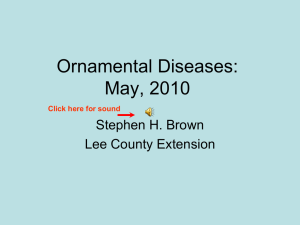
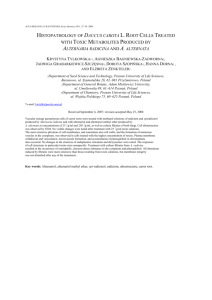
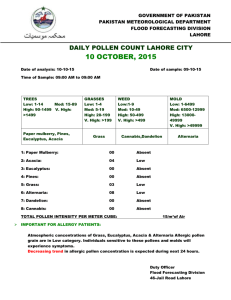
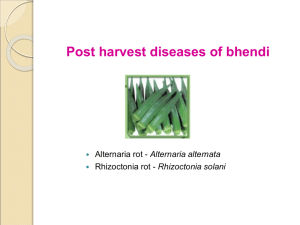
![[1] Barry's website: http://ag.arizona.edu/PLP/alternaria/online/ [2] G](http://s3.studylib.net/store/data/008567599_1-6696da84c67288cf7a604a7f7bab6db1-300x300.png)
